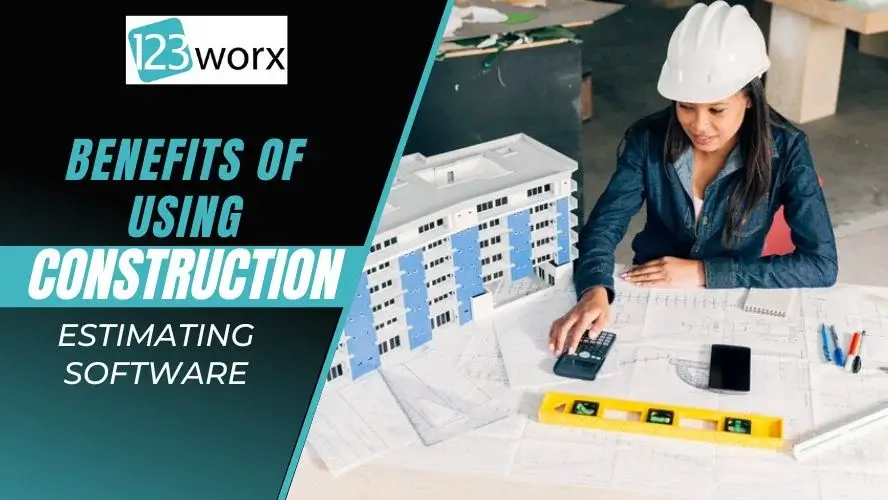Construction projects cost evaluation is one of the biggest challenges for contractors as the success of a project depends on its budget. It really requires accurate estimation. In the past, manual estimating was the way used by contractors which takes lot of time and often gives output incorrectly. With the evolution of Construction Estimation Software, professionals in the construction industry can now incorporate their processes for greater efficiency and accuracy.
Some of the key benefits drawn from such software includes improved efficiency and accuracy, savings of time and cost, and upgrades in construction project management and decision-making.
In this article, we’ll dive into the aspects to keep in mind while selecting construction estimating software that can help contractors simplify construction costing and estimating processes. Additionally, we’ll provide tips on successfully setting up this technology in your company.
Introduction to Construction Estimating Software
Estimation is one of the most critical factors in a construction project. It involves determining the number of materials, labor, and equipment and the related costs of the project. Usually, this is carried out manually, by the estimators depending on their knowledge and experience to come up with an accurate estimate. However, the manual process is labor-intensive and prone to errors.
Construction estimating software streamlines the industry by automating cost calculations. This software uses advanced algorithms and databases to provide quick and precise project estimates. It speedily crunches numbers to give an in-depth cost breakdown. This happens in a fraction of time compared to the manual methods, using project parameters such as project size, needed materials, and worker pay rates.
The Challenges of Manual Estimating Processes
This approach may fail to be successful in projects, as manual estimating faces a few challenges that must be addressed.
Firstly, the process of manual estimation is time-consuming: Estimators have to calculate quantities manually and look up material costs. This can consume a lot of time, hence increasing project timescales and costs.
Secondly, the manual estimating process is prone to errors: The estimator can make a mistake in calculating the quantity, miss out on some essential facts, or even make basic math errors. These errors will lead to inaccurate estimates and can quickly bring a whole project down. An incorrect estimate may lead to budget overruns, delays, and disputes with clients or subcontractors.
Lastly, manual processes can never scale up with modern construction projects: Automation is required when the projects become complex and larger in scale; hence, depending on manual methods becomes absurd and ineffective. Estimators can be overwhelmed by the sheer number of calculations needed, producing a higher likelihood of errors and delays.
Benefits of Construction Estimating Software
More Efficient and Accurate Estimation
Using estimating software in construction can save time. By leveraging automated calculation features within the software, an estimator saves a lot of time that could be spent on calculations. This allows the estimators to concentrate on other essential tasks, including reviewing and refining the estimates, communicating with stakeholders, and analyzing project data.
Moreover, construction estimating software saves time and ensures the estimation is more accurate. On the contrary, automated calculations and updated material and labor costs allow estimators a better chance of making more precise estimates. This improved accuracy means that the risk of expensive mistakes is lower and that projects are more adequately budgeted. This allows contractors to confidently place bids for their projects, reassuring their expenses are practical and can compete with others.
Time and Money Savings with Construction Estimating Software
With construction estimating software, we see improved accuracy and boosts in material, time, and cost savings. All these calculations are done in an automated way that helps to streamline the estimation process and enables more estimations in less time than it would take manually.
This creates an opportunity for construction companies to tender more bids on projects, opening doors for potential revenue growth.
Construction cost estimating software also pinpoints where cost-saving opportunities can be found. Material and labor are transparent so that estimators can make project cost estimates based on optimization. They can compare suppliers and subcontractors, evaluate alternative construction methods, compare scenarios, and choose the most cost-effective option. The opportunity to save costs on such choices can bring about substantial savings over a project.
Efficient Project Management and Decision-making
Construction estimating software can give helpful insights into improvements in project management and decision-making. If estimations are accurate and detailed, project managers can make resourceful planning and allocation. This software also identifies issues and helps to keep projects on track by adjusting schedules. Further, the software tracks the estimated costs by comparing the actual expense to the estimated costs and supports active cost management.
In the context of decision-making, construction estimating software provides real-time data and analytics that offer real-time facts and analysis. It provides estimators and project managers with detailed reports on the project cost, quantities of materials, and labor productivity. This information helps them make choices while making decisions that bring the best project results with less risk. With construction estimating software, construction experts can make decisions that contribute positively to project success.
Features to Consider When Choosing Construction Estimating Software
Choosing the best construction estimating software is the very first step towards knowing the full benefits of this software.
Here are some of the key features you should look when evaluating different software:
1. User-friendly interface: Look for software with an intuitive interface, simple navigation, and a user-friendly interface. This will ensure the estimators can use the software quickly and efficiently without trouble. In other words, it must take minimal time for training with shorter learning curve.
2: Integration capabilities: Consider the software that can easily integrate with other running tools or systems in your organization, like accounting systems, project management software, or even BIM software. This can allow the smooth sharing of data and improved collaboration. Small and medium size companies should consider buying integrated software that comes with estimation software along with all the other project management features.
3: Database and Material Libraries: It’s vital to have databases and material libraries for accurate estimates. Make sure that it contains up-to-date databases of material costs, labor rates, and equipment costs. Further, the software should also allow users to set up and design material libraries.
4: Reporting and Analysis: Look for solid reporting and analysis capabilities in the software.
The software should clearly display project costs, material amounts, work efficiency, and much more. These reports provide important insights required during decision-making and project management.
5: Cloud-based collaboration: Opt for cloud-based construction software that supports real-time teamwork. It allows access to project data from anywhere at any given time. Further, its mobile accessibility lets the estimators update estimates on the go, thus enhancing efficiency and productivity.
How to Implement Construction Estimating Software in Your Organization?
Implementing construction estimating software in your organization must be well-planned and executed. The following steps will help guide you with the implementation steps:
- Analyze what you need: To determine the unique requirements of your organization, whether small or large, will specifically need while estimating. Project size, volume of estimates, level of detail required, etc., should be considered.
- Research and select software: Explore the number of different constructions estimating software that perfectly suits your requirements. Look at features, pricing, user reviews, and support services to shortlist your preferences and decide.
- Prepare your Team: Introduce the software to your estimating team with guidance and support. Familiarize them with the software’s layout, features, and capabilities. Foster clear communication and tackle any issues or inquiries from them.
- Pilot Implementation: Conduct a pilot phase, to begin with a test software run and look for any bugs or issues. Start with a small project or part of your estimating team and estimates Collect thoughts and tweak things as needed before introducing the software to everyone. Gather feedback and make necessary adjustments before introducing the software to everyone.
- Monitor and Evaluate: Monitor continuously the application and use of the software. Evaluate its impact on project efficiency, accuracy, and overall performance. It is recommended to get feedback from estimators and project managers on what’s required. Also, consider reviewing the work routine in needy areas.
- Optimize and Scale – Use the implemented software’s advanced functionalities to get the most out of it. Use additional integration with other applications and custom workflows, and tweak the software to align with your organization’s changing needs. Expand the software’s capacity as your entity grows, tackling larger projects and managing greater estimating volumes.
Embracing Technology for Better Construction Estimating
Construction estimating software can lead to a broad set of benefits that greatly enhance efficiency and accuracy in the estimation process.
It involves automated calculations, real-time data, and analytics that enhance the ease of collaboration among construction professionals. This helps to make smarter choices, cut costs, and improve project outcomes.
To maximize the benefits of construction estimating software, evaluate the diverse options, select software that aligns well with your organization’s needs, and then implement it effectively.

As a Vice President at 123worx, Construction Management Platform, Bharat Rudra has worked with hundreds of business executives searching for best-suited software for their construction business with a wide array of requirements. Bharat takes pride in helping construction businesses solve their business and project management challenges. Feel free to reach Bharat if you have any questions. You can find him on LinkedIn or reach him at brudra@123worx.com


Recent Comments